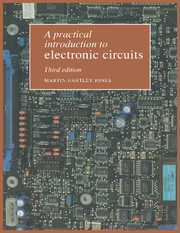Book contents
- Frontmatter
- Contents
- Preface to the third edition
- Preface to the second edition
- Preface to the first edition
- 1 Amplification and the transistor
- 2 The field-effect transistor
- 3 Thermionic valves and the cathode-ray tube
- 4 Negative feedback
- 5 Impedance matching
- 6 Semiconductor device characteristics
- 7 Amplification at high frequencies
- 8 Low-frequency signals, d.c. and the differential amplifier
- 9 Power supplies and power control
- 10 Pulse handling and time constants
- 11 Integrated circuit analogue building bricks
- 12 Positive feedback circuits and signal generators
- 13 Digital logic circuits
- 14 Microcomputer circuits and applications
- Appendix 1 Component identification
- Appendix 2 Transistor selection
- Appendix 3 Op amp data
- Appendix 4 Digital IC connections
- Appendix 5 Interfacing to the PC
- Bibliography
- Index
4 - Negative feedback
Published online by Cambridge University Press: 05 June 2012
- Frontmatter
- Contents
- Preface to the third edition
- Preface to the second edition
- Preface to the first edition
- 1 Amplification and the transistor
- 2 The field-effect transistor
- 3 Thermionic valves and the cathode-ray tube
- 4 Negative feedback
- 5 Impedance matching
- 6 Semiconductor device characteristics
- 7 Amplification at high frequencies
- 8 Low-frequency signals, d.c. and the differential amplifier
- 9 Power supplies and power control
- 10 Pulse handling and time constants
- 11 Integrated circuit analogue building bricks
- 12 Positive feedback circuits and signal generators
- 13 Digital logic circuits
- 14 Microcomputer circuits and applications
- Appendix 1 Component identification
- Appendix 2 Transistor selection
- Appendix 3 Op amp data
- Appendix 4 Digital IC connections
- Appendix 5 Interfacing to the PC
- Bibliography
- Index
Summary
Introduction to feedback principles
The concept of negative feedback is fundamental to life. A simple experiment will illustrate this point: close your eyes and then bring your index fingers together so that they touch at the tips. You will probably miss. By closing your eyes you have broken a feedback loop which is vital to most human actions; in order to perform an operation accurately we must be able to see what we are doing and thus apply any small corrections as and when necessary. In effect, we are taking the output (the action) and feeding it back to the input (the mental ‘instruction’ or intention) in such a way that the output is made equal to the input. In other words, the action is forced to correspond exactly with the intention.
Examples of negative feedback can also be found in the field of mechanical engineering. One of the clearest examples is the governor which is used to control the speed of rotating machinery. The most spectacular form of governor used to be found on the old steam engines which were the prime source of motive power in the 19th century. The governor is shown in basic form in fig. 4.1 and consists of a vertical shaft geared up to the main flywheel shaft of the engine, carrying weights on a flexible linkage.
As the speed of the engine, and hence of the governor shaft, increases, centrifugal force causes the weights to fly outwards on their linkage.
- Type
- Chapter
- Information
- A Practical Introduction to Electronic Circuits , pp. 59 - 75Publisher: Cambridge University PressPrint publication year: 1995



